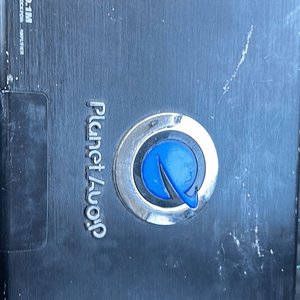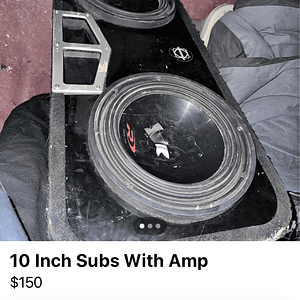gckless 5,000+ posts
CarAudio.com Veteran
Why are tube watts seemingly louder than solid-state watts?
It’s a common belief that tube amps are louder than solid state amps. I’ve seen little 30 watt tube amps blow away ginormous 100 watt solid state amps. This is not a myth, it’s a fact. Here’s why.
First, it must be pointed out that watts are watts. Tube wattage is not different from solid state wattage. It’s simply ohm’s law.
W = I2 x R
By any objective measure, 50 watts from a tube amp is identical to 50 watts from a solid state. "Watts" is a mathematical calculation of power consumption, not a measure of loudness. Loudness is measured in "decibels". Though higher watts does certainly mean higher volume, the only actual way to compare the volume output of any two amps is to measure the decibels they produce, for each amp, or type of amp, may have a different "efficiency". It's just like the fact that light bulbs are described per wattage, but the brightness of light is actually measure in "lumens". That's why a the new compact fluorescent light bulb listed as 15w (power consumed) puts out the same light as an old style 60w incandescent bulb (950 lumens).
So why do tube amps sound louder?
It comes down to two things. How the wattage of amps are rated and how tube amps clip/distort differently from solid state amps.
An amplifier’s wattage rating is not a measurement of its maximum output. The wattage of an amplifier is rated at its highest output without clipping.
Here’s a picture to show what clipping is:
View attachment 26546787
As the wattage is increased, the amplifier reaches a threshold where the highest outputs are clipped off. This clipping causes distortion.
The next part of the puzzle is this: tube amps clip different than solid state amps.
Tube amps clip gradually as the wattage is increased while solid state amps remain clean until they’re suddenly very clipped/distorted. In tube amps, this clipping is actually 3rd-order harmonic distortion (also some higher, and odd, order harmonics), and is very pleasing to our ears.
The gradual clipping of a tube amp adds to the flavor of an amp. A tube amp reacts to input, clipping a bit more with more input voltage, while remaining smooth with less input voltage. These subtle nuances add character to an amp's sound. The sudden massive clipping of a solid state simply sounds like poo. There are no subtle clipping nuances with a solid state amp, it’s either not clipped or fully clipped.
This is fundamentally why tube amps sound louder. Once clipping is reached, output power increases exponentially (to a point, and where that point is is different for solid state and tube amps). Ever notice how someone's sound system sounds so much louder when it's clipped? Well that's exactly what happens with tube amps, it's just the way they distort and clip are much different, it's pleasing to our ears and easier on loudspeakers. So if you turn up a solid state and a tube amp to 10, the solid state is pushing its full rated 50 watts, and probably sounds like poo because that harsh clipping would be starting while the tube amp would be pushing more than 50 watts. The tube amp would be clipping, but it would be that good sounding clipping.
It's also worth noting that most tube amps are of much higher quality than most solid-state amps. Of course this is a generalization, but most tube amps have higher quality components throughout the amp.
Also worth noting is that amplifier ratings aren't very useful because there is no standard for testing them. Tube amp ratings/specifications are generally more trustworthy because tube amp manufacturers usually have better intrumentation, and are more precise in measuring on purpose, for measuring amplifier output than their solid-state cousins. Ever notice how most consumers only care about wattage ratings when purchasing receivers? Those precise and specific measurements aren't necessary, so why spend the extra cash if it doesn't mean anything to most people? Multi-channel receivers are even worse because their ratings per channel are not valid for more than one channel being used at a time.
I should point out that I’m not arguing that tube amps are “better” than solid state amps. I’ve owned plenty of solid state amps in my life and only a few tube amps. And furthermore, objectively speaking, solid state amps are cleaner and are less prone to clipping. However, subjectively people like the sound and warmth of tube amps more, despite their objective faults. Well, that’s not right. People like the sound and warmth of tube amps more because of those faults. Plus they just look awesome //content.invisioncic.com/y282845/emoticons/smile.gif.1ebc41e1811405b213edfc4622c41e27.gif
It’s a common belief that tube amps are louder than solid state amps. I’ve seen little 30 watt tube amps blow away ginormous 100 watt solid state amps. This is not a myth, it’s a fact. Here’s why.
First, it must be pointed out that watts are watts. Tube wattage is not different from solid state wattage. It’s simply ohm’s law.
W = I2 x R
By any objective measure, 50 watts from a tube amp is identical to 50 watts from a solid state. "Watts" is a mathematical calculation of power consumption, not a measure of loudness. Loudness is measured in "decibels". Though higher watts does certainly mean higher volume, the only actual way to compare the volume output of any two amps is to measure the decibels they produce, for each amp, or type of amp, may have a different "efficiency". It's just like the fact that light bulbs are described per wattage, but the brightness of light is actually measure in "lumens". That's why a the new compact fluorescent light bulb listed as 15w (power consumed) puts out the same light as an old style 60w incandescent bulb (950 lumens).
So why do tube amps sound louder?
It comes down to two things. How the wattage of amps are rated and how tube amps clip/distort differently from solid state amps.
An amplifier’s wattage rating is not a measurement of its maximum output. The wattage of an amplifier is rated at its highest output without clipping.
Here’s a picture to show what clipping is:
View attachment 26546787
As the wattage is increased, the amplifier reaches a threshold where the highest outputs are clipped off. This clipping causes distortion.
The next part of the puzzle is this: tube amps clip different than solid state amps.
Tube amps clip gradually as the wattage is increased while solid state amps remain clean until they’re suddenly very clipped/distorted. In tube amps, this clipping is actually 3rd-order harmonic distortion (also some higher, and odd, order harmonics), and is very pleasing to our ears.
The gradual clipping of a tube amp adds to the flavor of an amp. A tube amp reacts to input, clipping a bit more with more input voltage, while remaining smooth with less input voltage. These subtle nuances add character to an amp's sound. The sudden massive clipping of a solid state simply sounds like poo. There are no subtle clipping nuances with a solid state amp, it’s either not clipped or fully clipped.
This is fundamentally why tube amps sound louder. Once clipping is reached, output power increases exponentially (to a point, and where that point is is different for solid state and tube amps). Ever notice how someone's sound system sounds so much louder when it's clipped? Well that's exactly what happens with tube amps, it's just the way they distort and clip are much different, it's pleasing to our ears and easier on loudspeakers. So if you turn up a solid state and a tube amp to 10, the solid state is pushing its full rated 50 watts, and probably sounds like poo because that harsh clipping would be starting while the tube amp would be pushing more than 50 watts. The tube amp would be clipping, but it would be that good sounding clipping.
It's also worth noting that most tube amps are of much higher quality than most solid-state amps. Of course this is a generalization, but most tube amps have higher quality components throughout the amp.
Also worth noting is that amplifier ratings aren't very useful because there is no standard for testing them. Tube amp ratings/specifications are generally more trustworthy because tube amp manufacturers usually have better intrumentation, and are more precise in measuring on purpose, for measuring amplifier output than their solid-state cousins. Ever notice how most consumers only care about wattage ratings when purchasing receivers? Those precise and specific measurements aren't necessary, so why spend the extra cash if it doesn't mean anything to most people? Multi-channel receivers are even worse because their ratings per channel are not valid for more than one channel being used at a time.
I should point out that I’m not arguing that tube amps are “better” than solid state amps. I’ve owned plenty of solid state amps in my life and only a few tube amps. And furthermore, objectively speaking, solid state amps are cleaner and are less prone to clipping. However, subjectively people like the sound and warmth of tube amps more, despite their objective faults. Well, that’s not right. People like the sound and warmth of tube amps more because of those faults. Plus they just look awesome //content.invisioncic.com/y282845/emoticons/smile.gif.1ebc41e1811405b213edfc4622c41e27.gif


